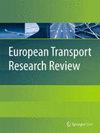在公共交通规划中处理社会因素和不同群体的需求:对定义、方法和知识差距的审查
IF 4.2
3区 工程技术
Q1 TRANSPORTATION
引用次数: 0
摘要
本文分析了将社会因素纳入公共交通规划的问题。本文探讨了如何平衡社会效益与效率和成本最小化等目标之间的关系。通过文献综述,本文研究了针对潜在弱势群体的公共交通可达性评估方法,并确定了现有研究中的知识差距。分析表明,研究重点主要集中在实施后(事后)的无障碍评估,而缺乏对规划阶段潜在影响(事前)的研究。此外,本文还发现,在如何权衡社会效益与其他更常规的目标(如效率和成本最小化)以及环境因素方面缺乏研究。研究通常仅仅基于改善潜在弱势群体的可及性的愿望,提出事后变革建议。因此,有必要就如何管理规划中的利益冲突开展更多研究,例如通过综合方法。本文还强调了研究忽视所开发方法的实际可用性的倾向。这些方法与负责规划公共交通系统的决策者和规划者的相关性在很大程度上仍未得到探讨。为了开发出实际有用的方法,研究工作需要更好地理解规划实践的规范。在讨论如何满足潜在弱势群体的交通需求时,通常会脱离政策背景。对于公共交通规划实践中如何处理社会、经济和环境因素之间的潜在矛盾,还需要进行更多的研究。所有这些都有可能导致理论与实践脱节,即研究与公共交通提供者的实际需求脱节。通过提出一种更细致入微的研究方法,更好地反映现实世界规划的复杂性和用户群体的不同需求,研究可以使公共交通规划实现我们所说的 "可持续无障碍"。本文章由计算机程序翻译,如有差异,请以英文原文为准。
Handling social considerations and the needs of different groups in public transport planning: a review of definitions, methods, and knowledge gaps
This paper analyses the integration of social considerations into public transport planning. It addresses the challenge of balancing social benefits against objectives such as efficiency and cost minimization. Through a literature review, this paper examines methods for assessing public transport accessibility for potentially disadvantaged groups and identifies knowledge gaps in existing research. The analysis reveals a predominant focus on post-implementation (ex-post) accessibility assessments and a lack of research examining potential impacts (ex-ante) during planning stages. Furthermore, the paper identifies a lack of research on how to weigh social benefits against other more conventional objectives such as efficiency and cost minimization and also against environmental considerations. Research usually proposes changes ex-post based solely on a desire to improve accessibility for potentially disadvantaged groups. Therefore, there is a need for more research on how to manage conflicting interests in planning, for example through composite methods. The paper also highlights the tendency of research to overlook the practical usability of methods developed. The relevance of methods to policy makers and planners responsible for planning public transport systems remains largely unexplored. To develop practically useful methods, research needs a better understanding of the norms governing planning practices. It is common to discuss how the mobility needs of potentially disadvantaged passenger groups should be met in isolation from policy contexts. More research is needed about how the potential tensions between social, economic, and environmental considerations play out in public transport planning practices. All of this leads to a risk of a theory–practice gap, marked by a disconnect between research and the practical needs of the public transport providers. By proposing a more nuanced research approach that better reflects the complexity of real-world planning and the different needs of user groups, research can enable public transport planning for what we term ‘sustainable accessibility’.
求助全文
通过发布文献求助,成功后即可免费获取论文全文。
去求助
来源期刊

European Transport Research Review
Engineering-Mechanical Engineering
CiteScore
8.60
自引率
4.70%
发文量
49
审稿时长
13 weeks
期刊介绍:
European Transport Research Review (ETRR) is a peer-reviewed open access journal publishing original high-quality scholarly research and developments in areas related to transportation science, technologies, policy and practice. Established in 2008 by the European Conference of Transport Research Institutes (ECTRI), the Journal provides researchers and practitioners around the world with an authoritative forum for the dissemination and critical discussion of new ideas and methodologies that originate in, or are of special interest to, the European transport research community. The journal is unique in its field, as it covers all modes of transport and addresses both the engineering and the social science perspective, offering a truly multidisciplinary platform for researchers, practitioners, engineers and policymakers. ETRR is aimed at a readership including researchers, practitioners in the design and operation of transportation systems, and policymakers at the international, national, regional and local levels.
 求助内容:
求助内容: 应助结果提醒方式:
应助结果提醒方式:


